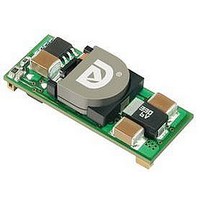LSM-1.5/10-D5-C Murata Power Solutions Inc, LSM-1.5/10-D5-C Datasheet - Page 7

LSM-1.5/10-D5-C
Manufacturer Part Number
LSM-1.5/10-D5-C
Description
DC/DC Converter
Manufacturer
Murata Power Solutions Inc
Series
LSMr
Datasheet
1.LSM-2.510-D5-C.pdf
(13 pages)
Specifications of LSM-1.5/10-D5-C
Dc / Dc Converter O/p Type
Fixed
No. Of Outputs
1
Input Voltage
4.5V To 5.5V
Power Rating
15W
Output Voltage
1.5V
Output Current
10A
Approval Bodies
EN, IEC, UL
Supply Voltage
5V
Product
Non-Isolated / POL
Output Power
15 W
Input Voltage Range
4.5 V to 5.5 V
Number Of Outputs
1
Output Voltage (channel 1)
1.5 V
Output Current (channel 1)
10 A
Output Type
Low Voltage
Lead Free Status / RoHS Status
Lead free / RoHS Compliant
Start Up Considerations
When power is first applied to the DC/DC converter, operation is different
than when the converter is running and stabilized. There is some risk of start
up difficulties if you do not observe several application features. Lower input
voltage converters may have more problems here since they tend to have
higher input currents. Operation is most critical with any combination of the
following external factors:
If the input voltage is already at the low limit before power is applied, the start
up surge current may instantaneously reduce the voltage at the input termi-
nals to below the specified minimum voltage. Even if this voltage depression
is very brief, this may interfere with the on-board controller and possibly
cause a failed start. Or the converter may start but the input current load will
now drive the input voltage below its running low limit and the converter will
shut down.
If you measure the input voltage before start up with a Digital Voltmeter
(DVM), the voltage may appear to be adequate. Limited external capacitance
and/or too high a source impedance may cause a short downward spike at
power up, causing an instantaneous voltage drop. Use an oscilloscope not a
DVM to observe this spike. The converter’s soft-start controller is sensitive to
input voltage. What matters here is the actual voltage at the input terminals
at all times.
Symptoms of start-up difficulties may include failed started, output oscillation
or brief start up then overcurrent shutdown. Since the input voltage is never
absolutely constant, the converter may start up at some times and not at
others.
1 - Low initial input line voltage and/or poor regulation of the input source.
2 – Full output load current on lower output voltage converters.
3 – Slow slew rate of input voltage.
4 – Longer distance to input voltage source and/or higher external input
5 - Limited or insufficient ground plane. External wiring that is too small.
6 – Too small external input capacitance. Too high ESR.
7 – High output capacitance causing a start up charge overcurrent surge.
8 – Output loads with excessive inductive reactance or constant current
source impedance.
characteristics.
www.murata-ps.com
Single Output, Non-Isolated, 5V
Solutions
To improve start up, review the conditions above. One of the better solutions
is to place a moderate size capacitor very close to the input terminals. You
may need two parallel capacitors. A larger electrolytic or tantalum cap sup-
plies the surge current and a smaller parallel low-ESR ceramic cap gives low
AC impedance. Too large an electrolytic capacitor may have higher internal
impedance (ESR) and/or lower the start up slew rate enough to upset the
DC/DC’s controller. Make sure the capacitors can tolerate reflected switching
current pulses from the converter.
The capacitors will not help if the input source has poor regulation. A
converter which starts successfully at 3.3 Volts will turn off if the input voltage
decays to below the input voltage theshold, regardless of external capaci-
tance.
Increase the input start up voltage if possible to raise the downward voltage
spike. Also, make sure that the input voltage ramps up in a reasonably short
time (less than a few milliseconds). If possible, move the input source closer
to the converter to reduce ohmic losses in the input wiring. Remember that
the input current is carried both by the wiring and the ground plane return.
Make sure the ground plane uses adequate thickness copper. Run additional
bus wire if necessary.
Any added output capacitor should use just enough capacitance (and no
more) to reduce output noise at the load and to avoid marginal threshold
noise problems with external logic. An output cap will also “decouple”
inductive reactance in the load. Certain kinds of electronic loads include
“constant current” characteristics which destabilize the output with insufficient
capacitance. If the wiring to the eventual load is long, consider placing this
decoupling cap at the load. Use the Remote Sense input to avoid ohmic
voltage drop errors.
An elegant solution to start up problems is to apply the input voltage with the
Remote On/Off control first in the off setting (for those converters with an
On/Off Control). After the specified start-up delay (usually under 20 mSec),
turn on the converter. The controller will have already been stabilized. The
short delay will not be noticed in most applications. Be aware of applications
which need “power management” (phased start up).
Finally, it is challenging to model some application circuits with absolute fidel-
ity. How low is the resistance of your ground plane? What is the inductance
(and distributed capacitance) of external wiring? Even a detailed mathemati-
cal model may not get all aspects of your circuit. Therefore it is difficult to
give cap values which serve all applications. Some experimentation may be
required.
IN
Technical enquiries email: sales@murata-ps.com, tel:
, 0.8-3.3V
LSM-10A D5 Models
OUT,
10A, DC/DC's in SMT Packages
MDC_LSM10A-D5.B01 Page 7 of 13
+1 508 339 3000






















